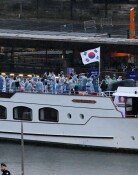There Is No Takeshima, Dokdos Rallying Cry
There Is No Takeshima, Dokdos Rallying Cry
Posted March. 20, 2005 22:22,
Last Saturday, the Dokdo islands were not the Calm East Islands at all, from sun up to sunset.
Peoples visits to Dokdo continued all day long, including such notables as police chief Huh Joon-young, head of the Cultural Properties Administration Yoo Hong-joon, the governor of Gyeongbuk Province, Lee Eui-geun, and other civic group members.
About 150 people visited Dokdo last Saturday, which is the highest daily total since Japans Shimane Prefecture passed its bill declaring Takeshima Day (Takeshima is the Japanese name for Dokdo), said police in charge of Dokdos defense.
Huh and Yoo arrived at the islands by helicopter around 11:30 a.m. Huh held a memorial ceremony in front of a monument located next to the camp of Dokdo guards and shook hands with 37 members of the guard, person by person, after looking around the waterfront guard posts and pier facilities.
There is no Takeshima on this earth. Only Dokdo deserves to exist, he said, adding, Dokdo no longer feels loneliness because police are defending it around the clock and the nations love for it is enormous, said Huh during his the trip to the islands last Saturday.
Yoo also said, Until now, as a means for the defense of Dokdo, we have only used structures. We need more. He announced six Dokdo remodeling plans, which aim to transform the islands into a tourist attraction,
The six plans include: remodeling one abandoned post into an observation platform for tourists; building a stone post which bears the words: Land of the Republic of Korea in Korean; establishing an information board for Dokdo; planting camellia (the flower of Ulleung County); replacing the handrail and stairway; and remodeling a post built by gravel into a restroom for tourists.
Yoo also said that instead of Koreas domain carved in Chinese characters on a small board next to a guard post, we will build a board saying: Territory of Republic of Korea written in Hunminjeongeum (a traditional written form of the Korean language) on a bluff that is large enough for tourists who get off ships to see easily.
Structures in Dokdo are not harmonious because they were built recklessly when they were needed, adding, I will build environmental-friendly structures here that can spotlight the beauty of nature in Dokdo, said Seung Hyo-san, an architect, who came along with Yoo.
Before their arrival, Grand National Party lawmakers and executives such as floor leader Kang Jae-sup, policy commission chair Maeng Hyung-gyu, and secretary general Kim Moo-sung also visited the islands around 9:30 a.m.
Following the partys executive meeting, they delivered a model Turtle Shipbuilt by Admiral Yi Sun-shin during a Japanese invasion of Korea and used to defeat the Japanese Navyto Dokdo police and urged Japan to withdraw the declaration of Takeshima Day and stop Japans distortion of history textbook.
The governor of Gyeongbuk-Province, Lee Eui-geun, also visited the islands, along with researchers of Korea Ocean Research and Development Institute.
About 80 members of civic organizations flew over and cruised in the waters of Dokdo. Five members of the Aircraft Owners and Pilots Associations Korea (AOPA) succeeded in flying over Dokdo for the first time on a civilian flight.
In addition, 16 members of the Korea Special Rescue Association (KSRA) set up a signal facing Japan, saying, Dokdo is the territory of the Republic of Korea in Korean, English, and Chinese characters 10 meters below sea level in the waters of Dokdo. About 80 people, including members of the KSRA and the junior chamber of the Gyeongbuk Province held a rally around the pier and denounced Japans scheme while burning a figure of Japanese Prime Minister Junichiro Koizumi.







